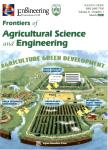Comparative transcriptomics revealed enhanced light responses, energy transport and storage in domestication of cassava(Manihot esculenta)
Comparative transcriptomics revealed enhanced light responses, energy transport and storage in domestication of cassava(Manihot esculenta)作者机构:The Institute of Tropical Bioscience and Biotechnology (ITBB) Chinese Academy of Tropical Agricultural Sciences (CATAS) Key Laboratory of Biology and Genetic Resources for Tropical Crops Ministry of Agriculture
出 版 物:《Frontiers of Agricultural Science and Engineering》 (农业科学与工程前沿(英文版))
年 卷 期:2016年第3卷第4期
页 面:295-307页
学科分类:0710[理学-生物学] 0831[工学-生物医学工程(可授工学、理学、医学学位)] 0905[农学-畜牧学] 0906[农学-兽医学] 09[农学] 0901[农学-作物学] 0836[工学-生物工程]
基 金:supported by the National Natural Science Foundation of China (31261140363, 31171230) the National Basic Research and Development Program (2010CB126601) China Agriculture Research System (CARS-12wwq) the Hainan Province Innovative Research Team Foundation (2016CXTD013)
主 题:cassava comparative transcriptomics energy transport photosynthesis starch synthesis
摘 要:Cassava is a staple food, feed and bioenergy crop important to the world especially in the *** cassava is characterized by powerful carbohydrate accumulation but its wild progenitor is ***, we investigated the transcriptional differences of eight c DNA libraries derived from developing leaf, stem and storage root of cassava cv. Arg7 and an ancestor line,W14, using next generation sequencing system. A total of41302 assembled transcripts were obtained and from these,25961 transcripts with FPKM≥3 in at least one library were named the expressed genes. A total of 2117, 1963 and3584 transcripts were found to be differentially expressed in leaf, stem and storage root(150 d after planting),respectively, between Arg7 and W14 and ascribed to 103,93 and 119 important pathways in leaf, stem and storage root, respectively. The highlight of this work is that the genes involved in light response, such as those for photosystem I(PSA) and photosystem II(PSB), other genes involved in light harvesting, and some of the genes in the Calvin cycle of carbon fixation were specially upregulated in leaf. Genes for transport and also for key rate-limiting enzymes(PFK, PGK and PK, GAPDH)coupling ATP consumption in glycolysis pathway were predominantly expressed in stem, and genes for sucrose degradation(INVs), amylose synthesis(GBSS) and hydrolysis(RCP1, AMYs), the three key steps of starch metabolism, and transport associated with energy translocation(ABC, AVPs and ATPase) and their upstream transcription factors had enhanced expression in storage root in domesticated cassava. Co-expression networks among the pathways in each organs revealed therelationship of the genes involved, and uncovered some of the important hub genes and transcription factors targeting genes for photosynthesis, transportation and starch biosynthesis.



